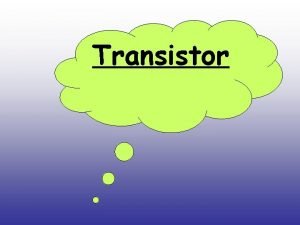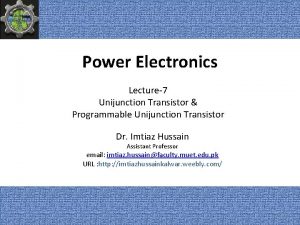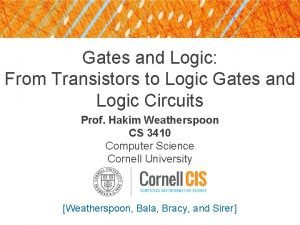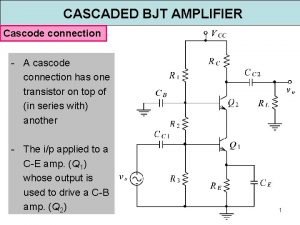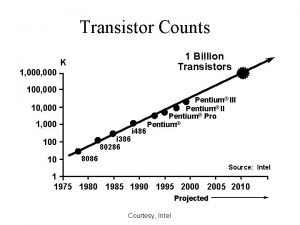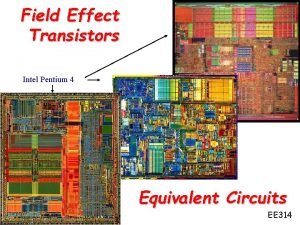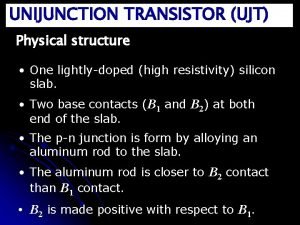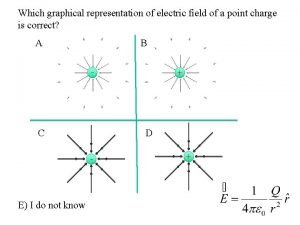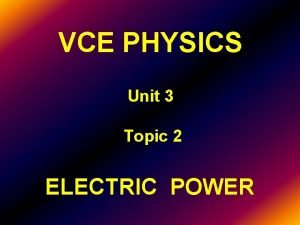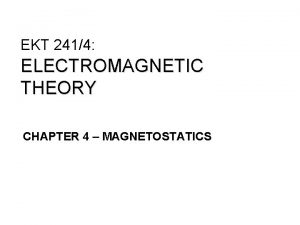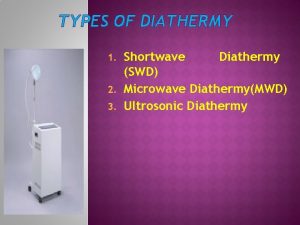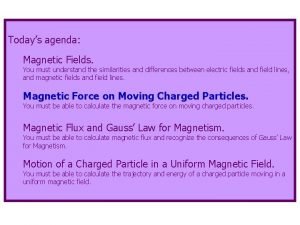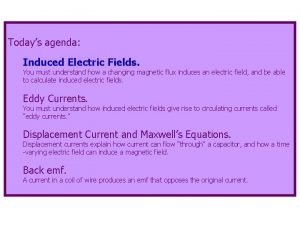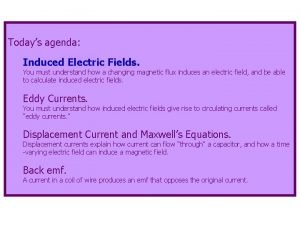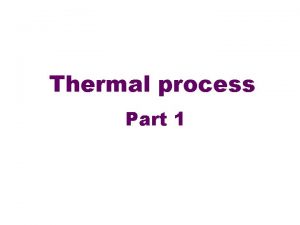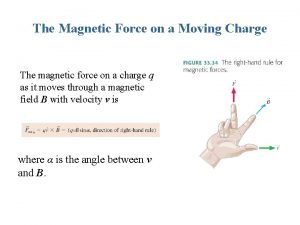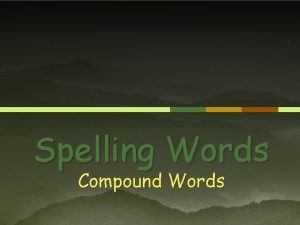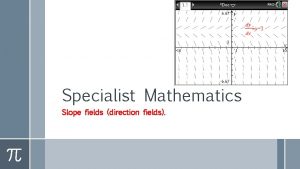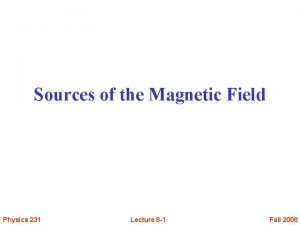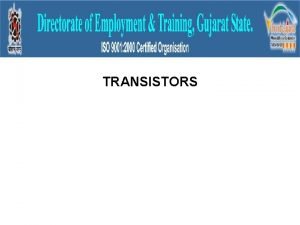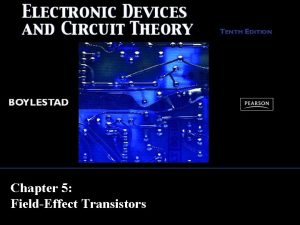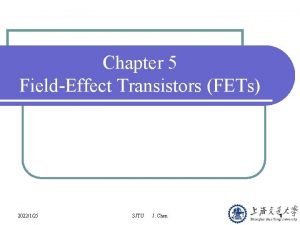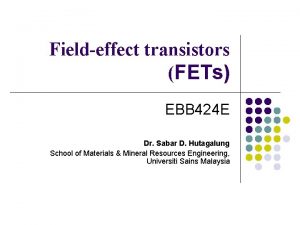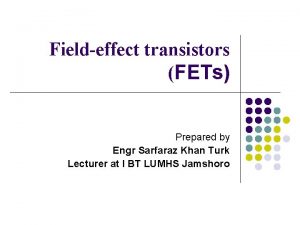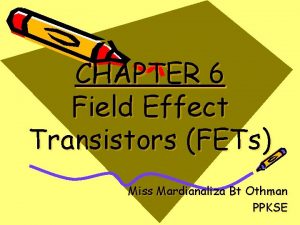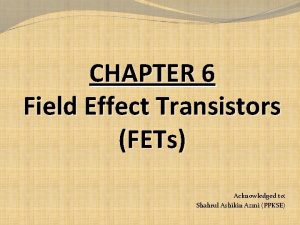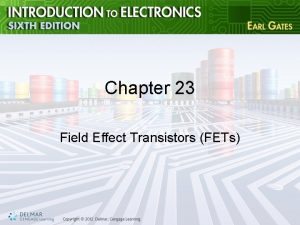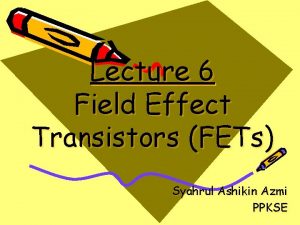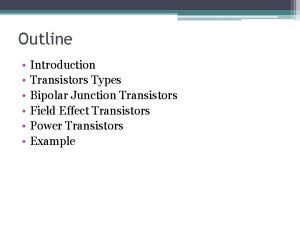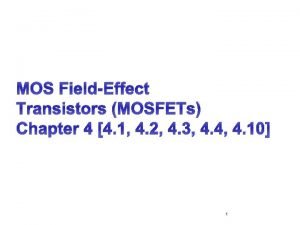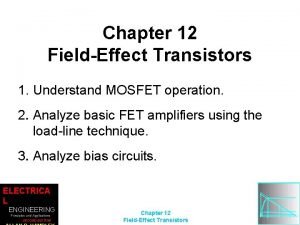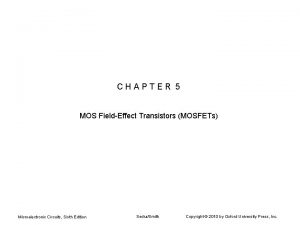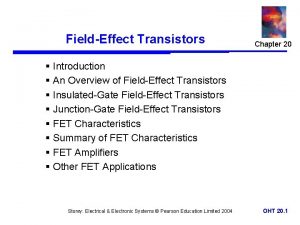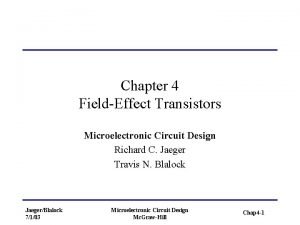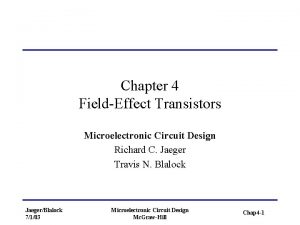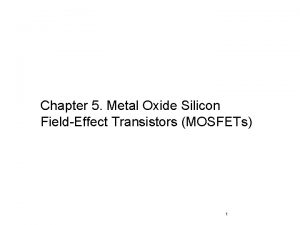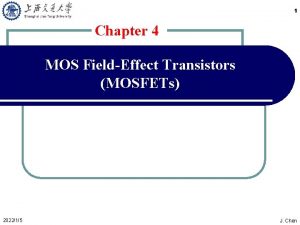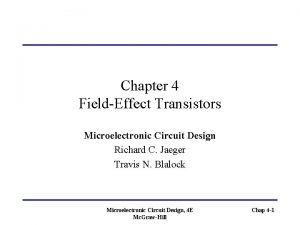Chapter 4 FieldEffect Transistors FETs 4 0 Field





























































- Slides: 61

Chapter 4 Field-Effect Transistors (FETs)

4. 0 Field Effect Transistors (FETs) 4. 1 The JFET 4. 2 JFET Characteristics and Parameter 4. 3 JFET Biasing 4. 4 MOSFET 4. 5 MOSFET Characteristics and Parameter 4. 6 MOSFET Biasing 4. 7 FET Amplification 4. 8 Common-Source Amplifiers 4. 9 Common-Drain Amplifiers 4. 10 Common-Gate Amplifiers

4. 1 The JFET (junction field effect transistor) is a type of FET that operates with a reverse biased pn junction to control current in a channel. Terminals of a JFET are source, gate, and drain. JFET can be either p-channel or nchannel. For n-channel JFET, two p-type are diffused in n-type material to form a channel, and both p-type are connected to gate lead. For simplicity, gate lead is shown connected to only one of the p regions. Basic structure of JFET schematic symbols

Basic Operation For n-channel, VDD provide drain-to-source voltage and supplies current from drain-to-source. VGG set reverse-bias voltage between gate and source. JFET always operated with the G-S pn junction reverse-bias. Reverse-bias gate-source junction, produce depletion region along pnjunction, which extend into n-channel, thus increase it’s resistance by restricting channel width. Channel resistance can be control by varying gate voltage, thereby controlling the amount ID. Increase VGG (reverse bias) will narrow the channel which increase the resistance of the channel and decreases ID. This field or resistance limits ID. With low or no VGG ID will maximum.

4. 2 JFET Characteristics and Parameters Ohmic region

4. 2 JFET Characteristics and Parameters Let’s look at the effects with a VGS = 0 V, by shorting gate to source. ID increase proportionally with increase of VDD from 0 V, (VDS increase as VDD increase). Here, the channel resistance is constant because the depletion region is not large enough to have significant effect. This is called the ohmic region (point A to B), because VDS and ID are related to Ohm law.

At B, curve level off and ID become almost constant and as VDS increases from B to C (active region), reverse-bias VGD produce large enough depletion region to offset increase in VDS, thus ID almost constant. For VGS = 0 V, value VDS at which ID become constant (Point B) is called pinch-off voltage, Vp and it value is fix for a given JFET. Continue increases in VDS above pinch-off produce almost constant ID and called maximum drain current IDSS, and it always specified for the condition, VGS = 0 V. Breakdown (Point C) is reached when ID begin increase rapidly with further increase VDS. It can damage the JFET, so it always operate below breakdown and within constant-current area (point B and C).

As VGS increases more negative by adjusting VGG, family of drain characteristic curves is produce. ID decreases as VGS is increased to larger negative because of the narrowing of the channel. For each increase in VGS, JFET reach pinch-off (where constant current begin), at value of VDS less than VP. So, ID is controlled by VGS. Value VGS that ID = 0, is called cutoff voltage, VGS(off). JFET must operate between VGS = 0 V and VGS(off). The ID vary from IDSS to almost zero. More negative VGS, the smaller ID becomes in the active region. When VGS has sufficient negative value, ID reduce to zero. Cut-off effect caused by widening of the depletion region to a point where it completely closes the channel. P-channel required negative VDD and positive VGS.

Comparison of Pinch-off Voltage and Cutoff Voltage There is difference between pinch-off and cut-off. VP is value of VDS at which ID become constant and always measure at VGS = 0 V. However, pinch-off occurs for VDS < VP when VGS non-zero. So, VP is constant, and minimum value VGS which ID constant varies with VGS(off) and VP always equal but opposite sign. Data sheet usually give either VGS(off) or Vp but not both. Example : If VGS(off) = -4 V and IDSS = 12 m. A, calculate min VDD for constant current area. VP = 4 V = VDS min value In constant current area, VGS = 0 V, ID = IDSS = 12 m. A VRD = IDRD = 12 m. A x 560Ω = 6. 72 V So, VDD = VDS + VRD = 4 V + 6. 72 V = 10. 7 V If VDD is increased to 15 V, what is drain current?

JFET Universal Transfer Characteristic Range of VGS from 0 V to VGSoff that control the amount of ID. For n-channel VGS(off) is negative and for p-channel VGSoff is positive. Because VGS does control ID, the relationship between these two quantities is important. From graph, ID = 0 when VGS = VGS(off) and ID = IDSS when VGS = 0.

Transfer characteristic curve can be develop by plotting ID for value VGS at pinch-off. Each point on transfer characteristic curve correspond to VGS and ID on drain curve. Example, when VGS =-2 V, ID = 4. 32 m. A and the VGS(off) = -5 V and IDSS = 12 m. A. Transfer characteristic can be express as ; ID = IDSS(1 - VGS/VGS(off))2 From data sheet, ID for VGS can be determine if VGS(off) and IDSS known. The parabolic relationship known as square law. JFET and MOSFET often referred as square-law devices.

JFET Data Sheet.

JFET Forward Transconductance Forward transconductance (transfer conductance), gm is the change in drain current (ΔID)for a given change in gate to source voltage (ΔVGS) with the drain to source voltage constant. Forward transconductance, gm = ΔID/ ΔVGS with VDS constant. Because transfer characteristic is non-linear, so gm value varies depend on curve set by VGS. A data sheet normally gives gm at VGS = 0 V (gm 0). Where gm 0 = (2 IDSS) / |VGS(off)|. So gm = gm 0(1 – (VGS/VGSoff)) EX : if gm 0 = 500 µS, VGS(off) = -6 V , VGS = -4 V and IDSS = 3. 0 m. A gm = 500µS(1 – 4 V/6 V) = 1667 µS ID = IDSS(1 – VGS/VGS(off))2 = 3. 0 m. A(1 – -4 V/-6 V) = 333 µA

Input Resistance and Capacitance JFET operate with reverse-bias, so input resistance at gate is very high. These is one advantage JFET over BJT. Data sheet often specify the input resistance by giving a value for the gate reverse current, IGSS. RIN = |VGS/IGSS|. IGSS increase with temperature, so RIN decrease. Input capacitance, Ciss, is a result of JFET operating with reverse-bias pnjunction and the value depends on amount of reverse voltage. EX : If IGSS = = -2 n. A VGS = -20 V So RIN = |20 V/2 n. A| = 10, 000 MΩ From drain characteristic curve, above pinch-off ID is relatively constant over VDS range, so large change in VDS produce small change in ID. The ratio drain to source resistance, r’ds = ΔVDS/ ΔID

4. 3 JFET Biasing Self-Bias Self-bias is most common for JFET. For n-channel G-S junction reverse-bias, VGS must negative. RG has no effect on bias because there is no voltage applied to gate and voltage to ground is 0 V. RG only to isolate an ac signal from ground in amplifier application. However, VGS will be positive and can be determined ID = IS for all JFET circuits. Is produce VRS and make source positive respect to ground. Since IS = ID and VG = 0, then VS = IDRS. VGS = VG – VS = 0 – IDRS = -IDRS For p-channel, IRS produce negative voltage at source, make gate positive respect with source. Since IS = ID, so VGS = IDRS. Self-biased JFETs (IS = ID in all JFETs)

VD = VDD – IDRD Since VS = IDRS, so VDS = VD – VS = VDD – ID(RD + RS) Example : Find VDS and VGS for circuit below ;

Setting the Q-Point of a Self-Biased JFET To establish bias point (Q-point) is to determine ID for desired VGS and calculate RS = | VGS/ID | For a VGS value, ID can be determine by transfer characteristic curve or using IDSS and VGS(off) from data sheet. Example : Find RS using transfer characteristic at VGS = - 5 V From graph, ID = 6. 25 m. A, so RS = |5 V/6. 25 m. A| = 800Ω

The data sheet provides IDSS and VGS(off). VGS is the desired voltage to set the bias. ID = IDSS(1 - VGS/VGSoff)2 Ex : Find RS if IDSS = 25 m. A and VGS(off) = 15 V, VGS = 5 V

Midpoint Bias Since midpoint biasing is the most common, where it allow the maximum amount of ID swing between IDSS and 0 V , and values of RS and RD will determine approximate midpoint bias. Half of IDSS would be ID that is midpoint. VGS to establish this can be determined by, VGS(off)/3. 4 ID = IDSS(1 – VGS/VGS(off))2 = IDSS(1 – (VGS(off)/3. 4)/VGS(off)) = 0. 5 IDSS To set drain voltage at mid point, VD = VDD/2, select RD to produce the desired voltage drop. Choose RG slightly larger to prevent loading on driving stage in cascade amplifier.

Ex : If IDSS = 12 m. A and VGS(off) = -3 V and VD= 6 V, find RD and RS. For mid-point ID = IDSS/2 = 6 m. A VGS = VGS(off)/3. 4 = -3 V/3. 4 V = 882 m. V RS = |VGS/ID| = 882 m. V/6 m. A =147Ω VD = VDD – IDRD = VDD – VD RD = (VDD - VD)/ID = (12 - 6)/6 m. A = 1 kΩ

Remember the purpose of biasing is to set a point of operation (Q-point). In a self-biasing type JFET circuit the Q-point is determined by the given parameters of the JFET itself and values of RS and RD. Setting it at midpoint on the drain curve is most common. One thing not mentioned in the discussion was RG. It’s value is arbitrary but it should be large enough to keep the input resistance high.

Graphical Analysis of a Self-Biased JFET The transfer characteristic curve along with other parameters can be used to determine the mid-point bias Q-point of a self-biased JFET circuit. First determine the VGS when ID is zero ; VGS = -IDRS (this establish a point at the origin on the graph, ID=0; VGS=0) Next, calculate VGS when ID=IDSS. Then draw a line to connect this 2 point (load line). Where the two lines intersect gives us the ID and VGS (Q-point) needed for mid-point bias. Note that load line extends from VGS(off) (ID= 0 A) to VP(ID = IDSS)

Ex: Determine Q-point if RS = 680 Ω For ID = 0 VGS = - IDRS = 0 x 680Ω = 0 IDSS = ID = 4 m. A VGS = -IDRS = -4 m. A x 680Ω Q - point from graph ID = 2. 25 m. A VGS = -1. 5 V

Voltage-Divider Bias Voltage-divider bias can also be used to bias a JFET. Voltage at source must be more positive than voltage at gate so R 1 and R 2 are used to keep gatesource junction in reverse bias. Operation is no different from self-bias. Source voltage, VS = IDRS Gate voltage, VG = (R 2/(R 1 + R 2))VDD VGS = VG – VS Source voltage, VS = VG - VGS Drain current, ID = VS/RS So, ID = (VG – VGS) / RS An n-channel JFET with voltage divider bias (IS=ID)

EX : If R 1 = 6. 8 MΩ, R 2 = 1. 0 MΩ, RD = 3. 3 KΩ, RS = 2. 2 KΩ, VD = 7 V and VDD = 12 V, find ID and VGS.

Graphical Analysis of a JFET with Voltage-Divider Bias In using transfer characteristic curve to determine the approximate Q-point we must establish the two points for the load line. The first point is ID = 0 and find VGS (note that VGS = VG when ID = 0). VGS = VG = (R 2/(R 1 + R 2))VDD The second point is find ID when VGS = 0, ID = VG/RS Transfer characteristics can vary for JFET of same type. This would adversely affect the Q-point. Voltagedivider bias is less affected by this than self-bias. This is an undesirable problem that in extreme cases would require trying several of the same type until you find one that works within the desired range of operation.

Ex : Determine the approx Q-point. For ID = 0, VGS = VG = 2. 2 MΩ/4. 4 MΩ x 8 V = 4 V For VGS = 0, ID = VG/RS = 4 V/3. 3 kΩ = 1. 2 m. A

4. 4 MOSFET Metal oxide semiconductor field effect transistor (MOSFET) has no actual pn junction as the p and n materials are insulated from channel by a silicon dioxide and static sensitive device and sometime called as IGFET. There are depletion MOSFET (D-MOSFET) and enhancement MOSFET (E-MOSFET). Drain and source D-MOSFET are diffuse into the substrate material and connected to isolated gate by a narrow channel. E-MOSFET has no structural channel.


D-MOSFET can be operated in depletion or enhancement modes and sometimes called depletion/enhancement MOSFET. Gate voltage can either positive or negative because it’s insulated from channel. n-channel MOSFET operates in depletion mode when negative gate-to-source voltage is applied and in enhancement mode when a positive gate-to-source voltage is applied. It normally operated in depletion mode. In schematic symbol, substrate, indicated by arrow, normally but not always connected internally to source. Sometime, there is a separate substrate pin. Inward arrow for nchannel and outward for p-channel.

In depletion mode, gate and channel act as capacitor and Si. O 2 insulating layer is the dielectric. Negative charge from gate repel conduction electrons from channel, leaving positive ion. So some n-channel electron is depleted, thus decrease channel conductivity. The greater the voltage on gate, the greater the depletion of n-channel electrons. When reach VGSoff, channel totally depleted and ID = 0. So ID will conduct when VGS between VGS(off) and 0 V. In enhancement mode, positive gate voltage, electron are attracted into channel, thus (enhancing) increasing channel conductivity.

E-MOSFET can operate only in enhancement mode and has no depletion mode. It differs in construction from D-MOSFET, that it no structural channel and substrate extends completely to Si. O 2 layer. For n-channel, positive gate voltage above threshold value induces a channel by creating a thin layer of negative charge in substrate region adjacent to Si. O 2 layer. Conductivity of channel is enhanced by increase VGS, thus pulling more electron into channel area. For gate voltage below threshold, there is no channel.

In E-MOSFET schematic symbol, broken line symbolize the absence of physical channel. Conventional enhancement MOSFET have long thin lateral channel, and this result a relatively high drain-to-source resistance and limits EMOSFET to low power applications. When gate is positive, channel is formed close to gate between source and drain.

Power MOSFET Structure Lateral double diffused MOSFET (LDMOSFET) is specifically designed for high power applications. It’s has shorter channel between drain and source, so lower resistance, which allow higher current and voltage.

V-groove MOSFET (VMOSFET) also specifically designed for high power applications by creating a shorter and wider channel with less resistance between drain and source. Shorter, wider channel allow for higher current thus, greater power dissipation and improve frequency response. It’s has two source connections, gate on top and drain on the bottom. Channel is induced vertically along both sided of v-shaped groove between drain and source connection. Channel length is set by layer thickness, which is controlled by doping density and diffusion time rather mask dimension.

TMOSFET is similar to VMOSFET except it doesn’t use v-shaped groove, so easier to manufacture. Gate structure is embedded in a silicon dioxide layer, and the source contact is continuous over the entire surface area. It achieve greater packing density while retaining short vertical channel advantage.

Dual gate MOSFET can be either depletion or enhancement and have two gates which helps control unwanted capacitive effects (reduced) so it can be used in high-freq RF amplifier application. The arrangement also allow for automatic gain control input in certain RF amplifiers.

4. 5 MOSFET Characteristics and Parameters D-MOSFET can operate either positive or negative gate voltage. The general transfer characteristic curve where VGS = 0 correspond to IDSS and where ID = 0 correspond to VGS(off) = -VP (as with the JFET). The square-law expression also applied to D-MOSFET curve. D-MOSFET general transfer characteristic curves

For D-MOSFET it’s enhancement mode also have to consider. Calculating ID with given parameters in enhancement mode and depletion mode is same. Note this equation is no different for ID than JFETs and that transfer characteristics are similar except for it’s effect in enhancement mode. ID = IDSS(1 - VGS/VGS(off) )2 Remember n and p channel polarity differences.

E-MOSFET uses only channel enhancement and for all practical purposes does not conduct until VGS (positive for n-channel) reaches threshold voltage, VGS(th). ID = 0 when VGS = 0 V so it’s don’t have IDSS. The transfer characteristic curve starts at VGS(th) rather than VGS(off) on the horizontal axis and never intersects the vertical axis. The equation for the E-MOSFET transfer characteristics curve is ID = K(VGS - VGS(th))2 where K = ID(on) /(VGS - VGS(th))2

Handling Precautions All MOS are subject to damage from electrostatic discharge (ESD). Excess static charge can be accumulated coz input capacitance combine with very high input resistance and can damage the device. The precaution when handling MOSFET are ; a. b. c. d. e. Should be shipped and stored in conductive foam. All instruments and metal benches in assembly and test should be connected to earth ground. Handler wrist strap should be connected to earth ground with a length of wire and high value series resistor. Don’t move MOS from circuit when power is on. Don’t apply signals to MOS device while dc power supply is off.

4. 6 MOSFET Biasing Three ways to bias a MOSFET are zero-bias, voltage-divider bias, and drain -feedback bias. For D-MOSFET zero biasing has no applied bias voltage to the gate, VGS = 0 so an ac signal at gate varies the VGS above and below 0 V. Since VGS = 0, ID = IDSS VDS = VDD – IDSSRD RG is to accommodate an ac input signal by isolating it from ground. Since there is no dc gate current, RG does not affect the zero gate-tosource bias. A zero-biased D_MOSFET

Ex : Calculate VDS if VGS(off) = -8 V and IDSS = 12 m. A Since ID = IDSS = 12 m. A, so VDS = VDD – IDSSRD = 18 V – 12 m. A x 620Ω = 10. 6 V

For E-MOSFETs zero biasing cannot be used because VGS must higher then VGS(th) so only voltage-divider bias or drain-feedback. VGS = (R 2 / (R 1 + R 2)) x VDD VDS = VDD - IDRD where ID = K(VGS -VGS(th))2 and K = ID(on)/(VGS - VGS(th))2 With drain-feedback bias, IG = 0, there is no voltage drop across RG making VGS = VDS. With VGS given, ID = (VDD – VDS)/RD Voltage divider bias

Ex: If ID(on) = 200 m. A at VGS = 4 V and VGS(th) = 2 V, calculate VGS and VDS. VGS = (R 2 / (R 1 + R 2)) x VDD = 15 kΩ/115 kΩ x 24 V = 3. 13 V K = ID(on)/(VGS - VGS(th))2 = 200 m. A/4 V 2 = 50 m. A/V 2 ID for VGS = 3. 13 V is ; ID = K(VGS -VGS(th))2 = 50 m. A/V 2 x (3. 13 V – 2 V) = 63. 8 m. A VDS = VDD – IDRD = 24 V - 63. 8 m. A x 200Ω = 11. 2 V

4. 7 FET Amplification FET amplifiers are similar to BJT amplifiers in operation. The purpose of the amplifier is the same for both. FET amplifiers have certain advantages over BJT amplifiers such as high input impedance. However, BJT normally has a higher voltage gain. There also similarities in three amplifier configurations of FET and BJTs. Common-source (emitter), common-drain (collector), and common-gate (base) are three FET amplifier configurations.

Transconductance, gm = ΔID/ ΔVGS. In ac gm = Id/Vgs, so Id = gm. Vgs Internal FET equivalent circuits There are internal gate to source resistance (r’gs), current source is gm. Vgs and internal drain-to-source resistance ( r’ds). Resistance r’gs can be neglected since it is so large in value and in most cases r’ds can be neglected as well.


Voltage gain, AV = Vout/Vin = Vds/Vgs. Since Vds = Id. Rd, Vgs = Id/gm So, Av = Id. Rd/(Id/gm) =(gm. Id. Rd)/Id A V = g m Rd Example : If gm = 4 ms and Rd= 1. 5 kΩ, calculate Av Av = 6 Simplified FET equivalent circuit with an external ac drain resistance

4. 8 Common-Source Amplifiers Common-source amplifier is one in which the ac input signal is applied to the gate and ac output signal is taken from the drain. It either has no source resistor or has a bypassed source resistor. RG is to keep gate at 0 V dc because IGSS is so small and it’s large value to prevent loading of ac signal source. Bypass C 2, keeps the source of JFET at ground. Vin cause Vgs to swing along Qpoint and also do Id. As Id increases, VRD increase, VD decrease. Vds also swing along Q-point and 1800 out of phase with Vgs.

DC Analysis Capacitors are viewed as open when doing dc analysis. Normally the value is ID = IDSS(1 – (IDRS/VGSoff))2 JFET common source amplifier DC equivalent for the amplifier

AC Equivalent Circuit Capacitors effectively as shorts and Xc = 0. Notice that dc source is at ground and RD and RL are in parallel. This will lower Av by lowering the overall drain resistance, Rd.

Since input resistance is extremely high, so Vin at gate will be very little voltage drop across internal source resistance, where Vgs = Vin A v = g m Rd Vout = Vds = Av. Vgs or Vout = gm. Rd. Vin Where Rd = RD||RL and Vin = Vgs

Effect of an AC Load on Voltage Gain When RL is connected to amplifier output through coupling capacitor C 3, so Rd = RD||RL because the upper RD is at ac ground. Input Resistance. Rin is extremely high and it approach infinite and can be neglected. Rin is reverse-bias in FET and insulated gate in MOSFET. The actual Rin is gate to ground, RG parallel with FET input resistance, RIN(gate) is VGS/IGSS. So Rin = RG || (VGS/IGSS)

Ex : If IGSS = 30 n. A and VGS = 10 V, find Rin.

D-MOSFET Amplifier Operation Normally zero biased D-MOSFET amplifier with ac capacitive couple and it is quite easy to analyze drain circuit since ID = IDSS. Gate is approx 0 V dc and source at ground, so VGS = 0 V. VD = VDD - IDRD Signal voltage cause Vgs to swing at 0 V. Negative Vgs swing produce depletion mode and Id decrease. Positive Vgs swing produce enhancement mode and Id increase. Depletion-enhancement operation Zero-biased D-MOSFET common source amplifier of D-MOSFET

E-MOSFET Amplifier Operation For a voltage-divider biased E-MOSFET, circuit voltage divider set the VGS needed to set Q-point above threshold. Value of K for dc analysis of ID is ; K = ID(on) /(VGS - VGS(th))2 ID = K(VGS – V GS(th))2 As with JFET and D-MOSFET, the signal voltage produces a swing in VGS above and below its Q point value, VGSQ. This cause Id swing above and below its Q point value, IDQ.

It use voltage-divider bias for VGS > VGS(th) VGS = (R 2/(R 1+R 2)) x VDD ID = K(VGS – VGS(th))2 VDS = VDD – IDRD Av is same as JFET and D-MOSFET Rin = R 1||R 2||RIN(gate) Where RIN(gate) = VGS/IGSS

4. 9 Common-Drain Amplifiers Common-drain amplifier is similar to common-collector BJT amplifier in that Vin is same as Vout with no phase shift. Gain is actually slightly less than 1. Input signal is applied to gate, output is taken from source. It is known as source-follower. Self-bias is used in this circuit. Input is applied to gate through C 1, output is coupled to load resistor through C 2. There is no drain resistor. Vin = Vgs + Id. Rs Vout = Id. Rs Av = Id. Rs/(Vgs + Id. Rs) Id = gm. Vgs so Av = gm. Rs/(1 + gm. Rs) If gm. Rs >> 1, then good for Av = 1 Gate resistor, RG, input resistance looking at the gate, RIN(gate) Rin = RG||RIN(gate) where RIN(gate) = VGS/IGSS

4. 10 Common-Gate Amplifiers Common-gate is similar to common base BJT amplifier in that it has a low input resistance. Self-bias and gate is connected direct to ground. Input from source and output from drain. Av = Vd/Vgs = Id. Rd/Vgs = gm. Vgs. Rd/Vgs = gm. Rd Rd = RD||RL Both common source and common drain configuration have high input because the gate is input terminal. In contrast, common gate configuration where the source is the input terminal has a low input resistance. Iin = Is = Id = gm. Vgs ; Vin = Vgs Rin(source) = Vin/Iin = Vgs/gm. Vgs = 1/gm Rin = Rin(source)||RS

Example : Calculate Av and Rin if gm = 2000µS. Why VDD is neg. Av = 10 Rin(source) Rin = 452 Ω
 Fets històrics importants
Fets històrics importants Ies veles e vents
Ies veles e vents P type bjt
P type bjt The ratio of rb1 and rbb is called
The ratio of rb1 and rbb is called Application du transistor
Application du transistor Transistor or gate
Transistor or gate Cascode connection
Cascode connection 8086 transistor count
8086 transistor count Two steps
Two steps Physical structure of transistor
Physical structure of transistor Mega giga tera
Mega giga tera Transistors were used in which generation of computers
Transistors were used in which generation of computers Interpretations of more’s law assert that
Interpretations of more’s law assert that 21lwuy8i6hw -site:youtube.com
21lwuy8i6hw -site:youtube.com Field dependent vs field independent
Field dependent vs field independent Field dependent vs field independent
Field dependent vs field independent Q factor of capacitor
Q factor of capacitor E field h field
E field h field Data types and field properties
Data types and field properties Field dependent and field independent
Field dependent and field independent Difference between electric field and magnetic field
Difference between electric field and magnetic field Chapter 21 electric charge and electric field
Chapter 21 electric charge and electric field Chapter 21 electric charge and electric field
Chapter 21 electric charge and electric field K constant unit
K constant unit Chapter 21 electric charge and electric field
Chapter 21 electric charge and electric field General aseptic fields are managed critically
General aseptic fields are managed critically Reliance field services
Reliance field services Graphical representation of electric field
Graphical representation of electric field Electric field at a point formula
Electric field at a point formula A repeating disturbance that transfers energy
A repeating disturbance that transfers energy Optic tract lesions
Optic tract lesions Temporal island of vision
Temporal island of vision Conservative field
Conservative field Right hand palm rule magnetic field
Right hand palm rule magnetic field What is field of discourse
What is field of discourse Field climate metos
Field climate metos Triple jump steps
Triple jump steps Equation for electric field intensity
Equation for electric field intensity Carlsbad field office
Carlsbad field office Swd and mwd
Swd and mwd Virtual field trip to the amazon rainforest
Virtual field trip to the amazon rainforest 21lwuy8i6hw -site:youtube.com
21lwuy8i6hw -site:youtube.com Induced electric field
Induced electric field Induced electric field in solenoid
Induced electric field in solenoid Blanket field oxide
Blanket field oxide A pioneer in the field of telecommunications
A pioneer in the field of telecommunications Capacity building in the field of higher education
Capacity building in the field of higher education Integral of magnetic field
Integral of magnetic field Field area network fan
Field area network fan Magnetic field equation
Magnetic field equation Torsion
Torsion Kelemahan teori medan kristal
Kelemahan teori medan kristal Field, tenor and mode
Field, tenor and mode Member info
Member info Electric field of a finite line charge
Electric field of a finite line charge Is field trip a compound word
Is field trip a compound word Slope field ti nspire
Slope field ti nspire Magnetic field unit
Magnetic field unit Autumn rhythm (number 30) 1950
Autumn rhythm (number 30) 1950 Domain analysis in software engineering
Domain analysis in software engineering Psychology is a broad field
Psychology is a broad field Soccer vocabulary
Soccer vocabulary


